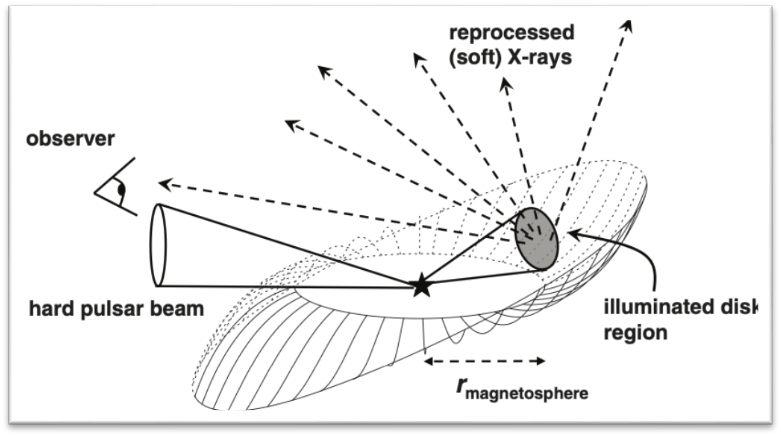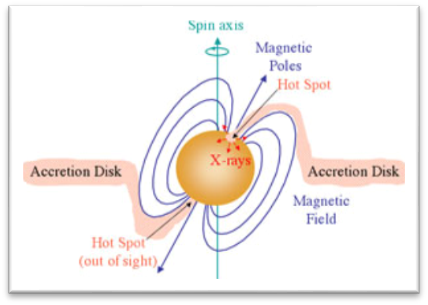Scientists have probed deeper into the coherent pulsations and milli-Hertz flickering earlier found in the binary star system ‘LMC X-4', located in the Large Magellanic Cloud (LMC), which is orbiting around our own Milky Way galaxy and measured it at a much higher energy band. This will help them probe the origins of the pulsation and flickering, also called quasi-periodic oscillations (QPOs), which are rare among luminous sources.
The LMC X-4 is a binary star system comprising a pulsar and a companion star. It is unique as it exhibits high variations in X-ray flux and harbors a 1.25 solar mass neutron star spinning at a period of 13.5 seconds. This class of binary X-ray sources, with one neutron star and another massive companion star, are believed to be progenitors of double compact binary systems. The massive companion star, when it undergoes a supernova explosion, will produce a second compact star-- either a neutron star or a black hole. If the binary system comes close to each other, they can merge to produce gravitational waves.
Therefore, the study of the binary evolution of these systems is of much interest to both X-ray astronomers and gravitational wave researchers. Last year, scientists from Raman Research Institute (RRI) spotted signals that were not purely periodic but flickers at a certain range of frequencies (or quasi-periodic oscillation) in LMC X-4 using data from the space observatory XMM-Newton of ESA.
In a recent paper, the same team from Raman Research Institute (RRI), an autonomous institute funded by the Department of Science and Technology (DST), detected obscuration of the pulsar by the companion star (complete X-Ray eclipse) and signals that were not purely periodic but flickers at a certain range of frequencies (quasi-periodic variations), of this binary star using data obtained from AstroSat, India's maiden space-based observatory launched by ISRO in September 2015.
The researchers observed a nearly 26 milli Hertz (mHz) quasi-periodic oscillation (QPO) feature in Large Area X-ray Proportional Counter (LAXPC) data which they found was originating due to inhomogeneity in the accretion disc, the study published in the Monthly Notices of the Royal Astronomical Society stated.
The AstroSat data helped researchers measure the QPOs at a much higher energy band than what was possible earlier, significantly helping to probe this phenomenon. Moreover, scientists found that the QPOs were not a permanent feature of this source, detectable only sporadically.
Generally, such QPO can be attributed to X-rays emitted from the accretion disc around the pulsar. These variations are believed to result from the interaction between the accretion disc surrounding the compact object and its strong gravitational field. The physical conditions and processes near the compact object can be probed by studying the frequency and amplitude of these variations.
Coherent pulsations in luminous binary star systems are relatively rare, but they can provide valuable information about the stars and their interactions. Pulsation signifies the rotation or changes in the rotation of a neutron star. They can rotate very fast and can complete one rotation in a few milliseconds to a few seconds. These pulsations occur when the two stars in the binary system are close enough to each other that they exchange matter and angular momentum. The change in pulsar rotation can be due to the angular momentum exchange between the neutron star and the accretion disc around it.
"For spectral analysis, we jointly used a Soft X-ray telescope (SXT) and LAXPC data. The persistent spectrum comprised of X-ray emission and reprocessed emission originating from the accretion column above the neutron star and the accretion disc, respectively. We also observed Iron and Neon emission lines," said Dr. Rahul Sharma, a post-doctoral fellow at RRI and lead author of the paper.
Coherent pulsations can also reveal information about the evolution of the binary system and could indicate that the stars are in the process of merging or that one star has accreted enough material from the other star to become a black hole or neutron star.
Currently, the team is studying the orbital evolution of the same source and is attempting to determine the rate and timescale of evolution.
Publication link: https://doi.org/10.1093/mnras/stac3572

Fig1:- Schematic of disk reprocessing in X-ray pulsars LMC X-4. The hard X-ray beam sweeps around and illuminates the accretion disc, which re-radiates a soft X-ray thermal component. Credit. Hung et al. (2010, APJ, 720, 1202).

Fig-2: Schematic diagram of an X-ray pulsar showing matter flowing into the magnetic field of a neutron star. The X-ray emitting hot spot rotate into and out of view giving rise to X-ray pulses. Credit: Swinburne University of Technology

Fig-3: Schematic diagram of an X-ray pulsar showing matter flowing into the magnetic field of a neutron star. The X-ray emitting hot spot rotate into and out of view giving rise to X-ray pulses. Credit: H. Brandt and imagine.gsfc.nasa.gov






























